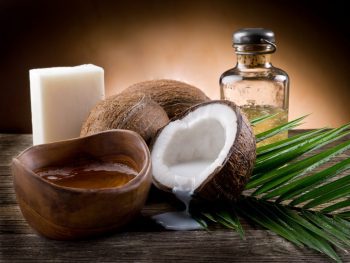By Sayer Ji
Contributing writer for Wake Up World
What you put on your skin goes directly into your body. Indeed, human autopsy studies have shown that mineral oil widely permeates our internal organs; major moisturizer brands have been found to cause tumor formation in treated animals. All the more reason why we need healthy “food cosmetics” as alternatives to petroleum-derived body care products.
It boggles the imagination how most mass market body care products today are almost entirely composed of petroleum-derived chemicals, whose toxicity are thoroughly established. Take parabens as an example. These endocrine-disrupting, estrogen-like petrochemicals have been found at concentrations 1 million times higher than the estrogen (estradiol) levels naturally found in human breast tissue, leading to the highly concerning conclusion that human hormones are now being eclipsed by synthetic chemicals.
When we slather these chemical concoctions onto our skin, they enter directly into the lymphatic and circulatory systems, depositing in internal organs and body fat. And unlike things you ingest orally, there is no “gate keeping” liver there to protect you from these chemicals entering rapidly into your body through your skin. This is why, of course, you should never put on your body anything you can not, or would not eat.
Unfortunately, major trusted brands have been found to be just as bad as more generic, cheaper ones in this respect, making it exceedingly difficult to avoid harm unless you are already wise to the issue and using completely natural body care products.
For instance, back in 2009, the Journal of Investigative Dermatology published a highly concerning study titled “Tumorigenic effect of some commonly used moisturizing creams when applied topically to UVB-pretreated high-risk mice,” wherein branded moisturizers, including Dermabase, Dermovan, Eucerin Original Moisturizing Cream (Eucerin), or Vanicream, were found to increase the rate of formation and number of tumors when applied topically to UVB-pretreated high-risk mice.[1]
Chemical industry public relations spokespersons love to point out that we are not mice, implying that preclinical research like this should not throw up a red flag. Should we be made to wait for the very industries guilty of poisoning us to voluntarily fund multi-million dollar, randomized, double-blinded, placebo-controlled trials to determine whether their products are not also causing cancer in humans? Short of a legal mandate, self-incriminating research like this will never be performed, and not only because such a study would be highly unethical (i.e. intentionally poisoning trial subjects), but because it will reveal a truth fraught with immense legal and financial liabilities. Needless to say, a logical approach would be to apply the precautionary principle so that when animal toxicological risk assessments show harm, instead of extrapolating an Orwellian “acceptable level of harm” to humans, we take the sane step of avoiding human exposure altogether.
Crude Awakening: Mineral Oil Contaminates Everyone’s Bodies
Sadly, the reality is that we are not only immersed in a sea of petrochemical products, but we bioaccumulate them in our bodies over the decades, carrying them with us to our early graves.
As we disclosed in a previous article titled “Crude Awakening: Mineral Oil Contaminates Everyone’s Bodies,” one of the only studies ever performed on the topic of petrochemical accumulation in the human body found that 48% of the livers and 46% of the spleens of the 465 autopsies analyzed showed signs of mineral-oil induced lipogranuloma (a nodule of necrotic, fatty tissue associated with granulomatous inflammation or a foreign-body reaction around a deposit of an oily substance), indicating just how widespread pathological tissue changes associated with petrochemical exposure really are.
And why should be surprised? Petroleum is everywhere. We build and power our cars from it. We implant plastic into our breasts, and we coat our vegetables with USDA/FDA-approved ‘food grade petroleum.’ Our entire global food system is driven by nitrogen urea based fertilizers, pesticides and related agrichemicals which are all petrochemical in origin. Oil derived hydrocarbons form the basis for the molecular building blocks of many synthetic patent medicines, and even some of our vitamins (e.g. dl-alpha tocopherol). Our foreign policy is largely based on invading countries for ostensibly political/ethical reasons who just happen to be sitting on ‘our oil’ (i.e. War = Resource Procurement). It is hard to imagine how we might escape our dependence on the petrochemical industrial establishment, given how vertically integrated it is into every facet of modern life, including the very fabric of our bodies.
But there are concrete steps we can take to improve the situation, starting with our own bodies. One of those is to bring back ancient ‘food cosmetics’ like coconut oil.
In a previous post, we discussed the 13 Evidence-Based Medicinal Properties of Coconut Oil, but we did not mention its beneficial effects on hair and skin. While coconut oil has been used for millennium as both food, medicine and cosmetic, only in the past few decades has scientific research emerged confirming its ancient uses.
Coconut Oil Is Superior to Mineral Oil for Treating Dry Skin
A 2004 randomized double-blind, controlled trial comparing extra virgin coconut oil with mineral oil as a moisturizer for mild to moderate xerosis (dry skin) found that coconut oil performed equally well, as far as objective measurements, and better than mineral oil, as far as the subjective perceptions of those using it.[2]
Coconut Oil Is Superior to Mineral Oil at Protecting the Hair
A 2001 study published in the Journal of Cosmetic Science found that coconut penetrates the hair shaft while mineral oil does not. This difference was attributed to coconut oil’s higher affinity with hair protein. The researchers explained their findings further: “
The results show that coconut oil penetrates the hair shaft while mineral oil does not. The difference may be due to the polarity of the coconut oil compared to the nonpolar nature of the mineral oil. The affinity of the penetrant to the protein seems to be the cause for this difference in their behavior. This study also indicates that the swelling of hair is limited by the presence oil. Since the process of swelling and deswelling of hair is one of the causes of hair damage by hygral fatigue, coconut oil, which is a better penetrant than mineral oil, may provide better protection from damage by hygral fatigue.[3]
Coconut Oil Protects the Scalp from Fungal Infections
Another study published back in 1993 in the journal Mycoses looked at the use of various commonly used hair oil preparations in India. They found that coconut oil was effective at inhibiting the skin fungi known as dermatophytes, lending a possible explanation for why the fungal infection of the scalp, a condition known as tinea capitis, is so rare in India.[4]
Coconut Oil + Anise Beats Pesticide Spray for Lice
A 2010 study published in the European Journal of Pediatrics found that coconut and anise spray can be a significantly more effective than the highly toxic insecticide Permethrin as an alternative treatment for head louse infestation.[5]
Increasingly, science confirms the value of traditional folk medicine in disease prevention and treatment. After many years of vast misrepresentation, coconut oil has gained wider acceptance not simply as a wholesome food, but as a medicinal agent capable of both nourishing and healing the body in ways that xenobiotic chemicals by their very nature can not.
Resources:
- [1] Yao-Ping Lu, You-Rong Lou, Jian-Guo Xie, Qingyun Peng, Weichung J Shih, Yong Lin, Allan H Conney. Tumorigenic effect of some commonly used moisturizing creams when applied topically to UVB-pretreated high-risk mice. J Invest Dermatol. 2009 Feb;129(2):468-75. Epub 2008 Aug 14. PMID: 18704106 – Article Published Date : Feb 01, 2009
- [2] Anna Liza C Agero, Vermén M Verallo-Rowell. A randomized double-blind controlled trial comparing extra virgin coconut oil with mineral oil as a moisturizer for mild to moderate xerosis. Dermatitis. 2004 Sep ;15(3):109-16. PMID: 15724344
- [3] S B Ruetsch, Y K Kamath, A S Rele, R B Mohile. Secondary ion mass spectrometric investigation of penetration of coconut and mineral oils into human hair fibers: relevance to hair damage. J Cosmet Sci. 2001 May-Jun;52(3):169-84. PMID: 11413497
- [4] A P Garg, J Müller. Inhibition of growth of dermatophytes by Indian hair oils. Mycoses. 1992 Nov-Dec;35(11-12):363-9. PMID: 1302812
- [5] Ian F Burgess, Elizabeth R Brunton, Nazma A Burgess. Clinical trial showing superiority of a coconut and anise spray over permethrin 0.43% lotion for head louse infestation, ISRCTN96469780. Eur J Pediatr. 2010 Jan ;169(1):55-62. Epub 2009 Apr 3. PMID: 19343362
Recommended articles by Sayer Ji:
- Brain Regeneration: Why It’s Real and How To Do It
- Research: Garlic is an Effective Natural Treatment for Heart Disease
- Wi-Fi Devices Increase Mercury Release From Dental Amalgams
- “Killer Germs” Obliterated by Medicinal Smoke Smudging, Study Reveals
- Turmeric’s ‘Smart Kill’ Properties Put Chemo & Radiation To Shame
- Beet Juice Boosts Cognitive Function In One Dose
- The Amazing Healing Properties of Apples
- 6 Bodily Tissues That Can Be Regenerated Through Nutrition
- How Turmeric Can Save the Aging Brain From Dementia and Premature Death
- Eating Wheat Feeds Disease-Causing Gut Bacteria, Study Suggests
- Toxic Algae: Causes of Florida’s Environmental Disaster Denied by Media and Authorities
About the author:
Sayer Ji is the founder of Greenmedinfo.com, a reviewer at the International Journal of Human Nutrition and Functional Medicine, Co-founder and CEO of Systome Biomed, Vice Chairman of the Board of the National Health Federation, and Steering Committee Member of the Global Non-GMO Foundation.
For more, visit GreenMedInfo.com and Facebook.com/GreenMedInfo, or sign up for GreenMedInfo’s free e-Newsletter.
© May 7th, 2013 GreenMedInfo LLC. This work is reproduced and distributed with the permission of GreenMedInfo LLC. Want to learn more from GreenMedInfo? Sign up for their newsletter here.

If you've ever found value in our articles, we'd greatly appreciate your support by purchasing Mindful Meditation Techniques for Kids - A Practical Guide for Adults to Empower Kids with the Gift of Inner Peace and Resilience for Life.
In the spirit of mindfulness, we encourage you to choose the paperback version. Delve into its pages away from screen glare and notifications, allowing yourself to fully immerse in the transformative practices within. The physical book enriches the learning process and serves as a tangible commitment to mindfulness, easily shared among family and friends.
Over the past few years, Wake Up World has faced significant online censorship, impacting our financial ability to stay online. Instead of soliciting donations, we're exploring win-win solutions with our readers to remain financially viable. Moving into book publishing, we hope to secure ongoing funds to continue our mission. With over 8,500 articles published in the past 13 years, we are committed to keeping our content free and accessible to everyone, without resorting to a paywall.









